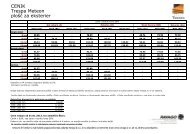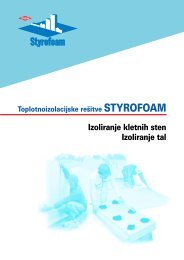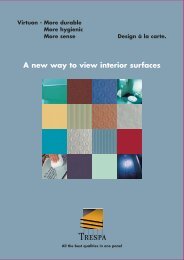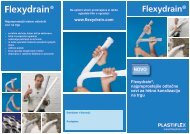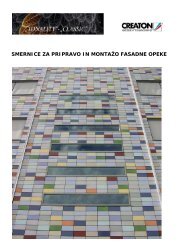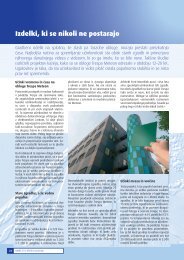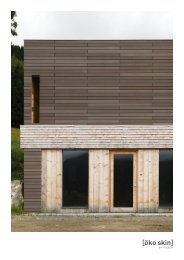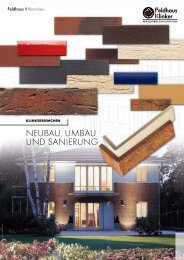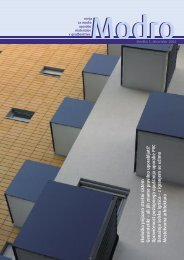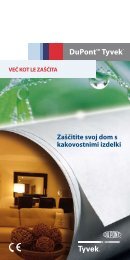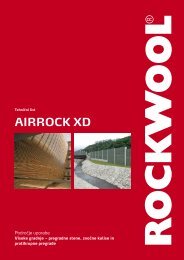Fibre C - Ravago
Fibre C - Ravago
Fibre C - Ravago
You also want an ePaper? Increase the reach of your titles
YUMPU automatically turns print PDFs into web optimized ePapers that Google loves.
Characteristics of fibreC<br />
Vivid signs of a natural building material<br />
Concrete is a natural product and Rieder sees it as such, with all<br />
its vital signs and characteristics. Living surfaces with the interplay<br />
of colour shades and light cloud effects, rather than dead and clinical<br />
surfaces are characteristic of fibreC. Even in the colouring of<br />
the concrete matrix, the focus is placed on meeting the ecological<br />
requirements of modern design. This is why the production involves<br />
natural raw materials to ensure the authenticity of all products.<br />
The demand for low porosity, homogeneous colour and strictly<br />
uniform smooth surfaces is not part of our sustainable philosophy.<br />
We consciously avoid chemical treatment and artificial materials to<br />
preserve the authenticity of the „green“ product fibreC. Colour and<br />
texture variations are a feature of our natural product.<br />
Concrete lives<br />
As the panels are not chemically treated or painted, small defects,<br />
dents, tension lines, efflorescences or flaws and textures may be<br />
visible (Data sheet exposed concrete 02/2004 [Publ.:BDZ/DBV]).<br />
When cement sets, it separates calcium hydroxide. This dissolves<br />
in water and can migrate to the concrete surface. When the water<br />
evaporates, the calcium hydroxide is returned to the surface and<br />
is converted to calcium carbonate (lime). If this natural process<br />
is intensified by unfavourable conditions, it leads to deposition of<br />
calcium carbonate, which is visible as a white efflorescence. Efflorescences<br />
are a natural feature of all cement-bonded composite<br />
materials.<br />
Part of nature - resistant & stable<br />
fibreC is not an artificially created material that exists cut off from<br />
the natural cycle of the environment. As adaptable and extraordinary<br />
the concrete skin is, it is just as authentic. fibreC is part of a<br />
natural cycle. Influencing variables for possible colour changes are<br />
temperature variations and differences in air humidity.<br />
Concrete is hygroscopic. It absorbs moisture and gives it off again.<br />
The large format of the panels means that moist spots may dry at<br />
different speeds. Visible colour changes may occur in an individual<br />
panel.<br />
particular in bright colours or fresh panels. They can be attributed<br />
to a natural hardening and drying process of organic substances.<br />
Tests and experiences have shown that this blue colouring on the<br />
cladding may disappear under the influence of UV and light. This<br />
occurs based on the climatic and environmental influences. Heat,<br />
insolation and dryness can in particular accelerate the process.<br />
Hydrophobising<br />
As a basic protection against environmental influences, fibreC<br />
comes with a transparent hydrophobic impregnation. The opaque<br />
hydrophobising emphasises the naturalness of the material. The<br />
gloss level of the hydrophobic impregnation has a visual influence<br />
on the surface appearance. The hydrophobising is permeable and<br />
therefore breathable. If the cladding panel is applied vertically, it<br />
provides solid basic protection against weathering, dust and dirt<br />
but scratching, pressurised liquids, oil, acids, strong alkaline substances,<br />
etc. are not protected by the hydrophobising. The hydrophobising<br />
may be reapplied to achieve increased protection of the<br />
panels and to prevent extreme environmental conditions and wear<br />
and tear through intensive cleaning.<br />
In addition to the basic protection of the hydrophobising, the glassfibre<br />
reinforced concrete panel can be provided with a polyurethane<br />
protection. Depending on the thickness of this layer, which wears<br />
over time with the cleaning of the panels, protection against graffiti<br />
or other effects of dirt may be provided. The natural look and<br />
surface feel of glassfibre reinforced concrete is impaired by this<br />
coating.<br />
Note:<br />
The surface characteristics described apply to the visible side of<br />
the cladding panel. fibreC sample panels can never reflect all of the<br />
above characteristics. In large-scale cladding applications, optical<br />
phenomena occur that cannot be detected on small sample panels.<br />
Visual changes like micro-cracks do not affect the technical characteristics<br />
of fibreC. The static functions, the long-term stability<br />
and fire resistance are not affected.<br />
Material<br />
A typical feature of highly-compressed, high-quality concrete surfaces<br />
is so-called blue- and green discoloration, which can occur in<br />
Blowhole Dent Depression<br />
10 mm 10 mm 10 mm<br />
Pores Tension Line Colour Variation<br />
10 mm 10 mm<br />
25



